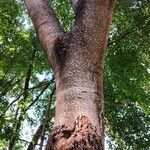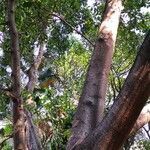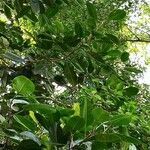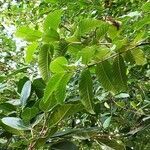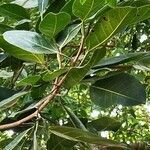Trees, 15-25 m tall, sometimes to 40 m tall. Trunk ca. 90 cm d.b.h. Bark brown. Petiolules short, less than 5 mm; leaflets 3-5 pairs, opposite, ovate or broadly elliptic to suborbicular, 4-14 × 3.5-6 cm, papery, base rounded and slightly oblique, apex rounded or emarginate. Inflorescence densely grayish yellow-green or grayish white puberulent; bracts and bracteoles per-sistent, ovate or triangular-ovate, equal in size, ca. 6 mm. Calyx tube 1-1.3 cm; lobes elliptic, 1-1.5 cm, apex rounded. Petal pale purple, obovate to suborbicular; claw white villous. Stamens 7, united at base; filaments exserted, 3-3.5 cm, pubescent in lower part. Ovary narrowly oblong, hairy; style elongated and exserted. Legume blackish brown, compressed, oblong, 11-17 × 7-8.5 cm, hard. Seeds 2-5, deep brownish red, shiny, slightly compressed, ovoid or suborbicular, ca. 2 cm. Fl. Apr-May, fr. Nov-Dec.
More
A tree. It grows to 30 m high. It loses its leaves during the year. The trunk is stout and up to 1 m across. The crown is rounded. The tree is usually divided near the base into large spreading branches. The bark is pale grey and slightly rough. The leaves are 18-25 cm long with 3-5 pairs of opposite leaflets. These are 5-9 cm long by 4-5 cm wide. The flowers are about 3 cm across and in branched clusters at the ends of the twigs. They have bright green sepals and one bright red petals. The fruit is a pod 12-20 cm long by 7-9 cm wide and dull brown. It split into 2 sections with 2-4 seeds. The seeds are black with a fleshy orange coat.
Dense forest, and in transitional areas between evergreen and dry open dipterocarp forest. Found in mixed deciduous or dry evergreen forest on clayey or laterite soils at elevations from 100-600 metres.
More
It is a tropical plant. It grows between 100-650 m above sea level in areas with a uniform rainfall. In XTBG Yunnan.
